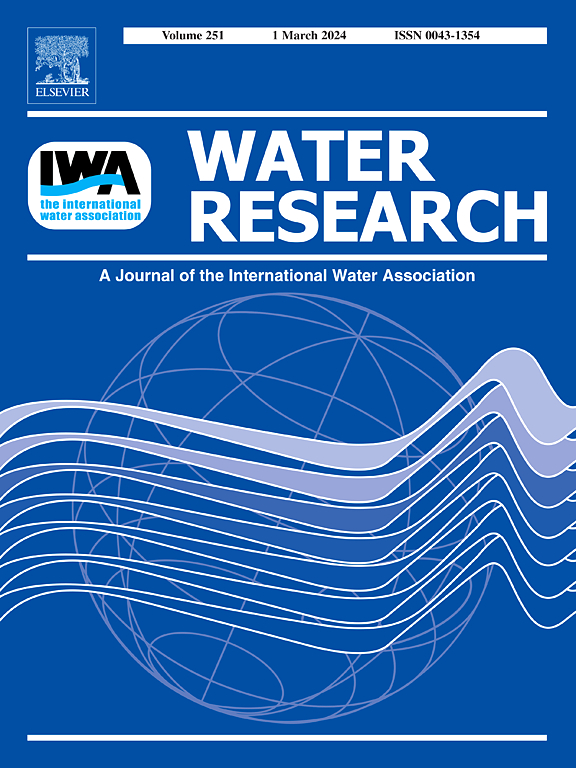Salinity regulates nutrient cycling via top-down and bottom-up forces in artificial cut-off tidal channels: Insights from multitrophic microbiota
IF 12.4
1区 环境科学与生态学
Q1 ENGINEERING, ENVIRONMENTAL
引用次数: 0
Abstract
Artificial cut-off of natural tidal meanders for flood control has substantially altered microbial communities and their role in nutrient cycling, yet the lack of comprehensive investigations into these specific anthropogenic impacts introduces greater uncertainty regarding the resultant water quality of nutrient-enriched estuaries. Here, we investigated how planktonic multitrophic microbiota and their mediated nutrient cycling respond to artificial meander cut-off using the environmental DNA (eDNA) approach. Results showed that despite the decline in α diversity of multitrophic microbiota, the nutrient cycling potential of the water column was enhanced 2.91-fold in the straight tidal channel. The artificial cut-off restructured the microbial food web, with trophic transfer efficiency from basal species to protozoa increasing. Salinity was identified to be the key environmental driver, mitigating the negative impact of decreased biodiversity on estuarine nutrient cycling potential by intensifying protozoan predation on heterotrophic bacteria (top-down forces). Additionally, salinity further enhanced environmental selection (bottom-up forces), reducing heterotrophic bacterial diversity while promoting the proliferation of functional microbial taxa, such as Comamonadaceae, Chitinophagaceae, and Rhodocyclaceae. This study offers novel insights into nutrient cycling in artificial straight tidal channels and provides critical foundations for optimizing restoration and management strategies in anthropogenically modified tidal river.


盐度通过人工切断潮汐通道中自上而下和自下而上的力量调节营养循环:来自多营养微生物群的见解
人为切断自然潮汐曲流以控制洪水,大大改变了微生物群落及其在营养循环中的作用,但缺乏对这些特定人为影响的全面调查,导致对营养丰富的河口的最终水质产生更大的不确定性。本文采用环境DNA (environmental DNA, eDNA)方法研究了浮游多营养微生物群及其介导的营养循环对人工曲流切断的响应。结果表明,在多营养菌群α多样性下降的情况下,直线型潮道水体的养分循环潜力提高了2.91倍。人工切断重组了微生物食物网,从基础物种到原生动物的营养转移效率提高。盐度被认为是关键的环境驱动因素,通过加强原生动物对异养细菌的捕食(自上而下的力量),减轻了生物多样性减少对河口营养循环潜力的负面影响。此外,盐度进一步增强了环境选择(自下而上的力量),减少了异养细菌的多样性,同时促进了功能微生物类群(如Comamonadaceae, Chitinophagaceae和Rhodocyclaceae)的增殖。本研究为研究人工潮汐直道营养循环提供了新的思路,为优化人工潮汐河道的修复和管理策略提供了重要依据。
本文章由计算机程序翻译,如有差异,请以英文原文为准。
求助全文
约1分钟内获得全文
求助全文
来源期刊

Water Research
环境科学-工程:环境
CiteScore
20.80
自引率
9.40%
发文量
1307
审稿时长
38 days
期刊介绍:
Water Research, along with its open access companion journal Water Research X, serves as a platform for publishing original research papers covering various aspects of the science and technology related to the anthropogenic water cycle, water quality, and its management worldwide. The audience targeted by the journal comprises biologists, chemical engineers, chemists, civil engineers, environmental engineers, limnologists, and microbiologists. The scope of the journal include:
•Treatment processes for water and wastewaters (municipal, agricultural, industrial, and on-site treatment), including resource recovery and residuals management;
•Urban hydrology including sewer systems, stormwater management, and green infrastructure;
•Drinking water treatment and distribution;
•Potable and non-potable water reuse;
•Sanitation, public health, and risk assessment;
•Anaerobic digestion, solid and hazardous waste management, including source characterization and the effects and control of leachates and gaseous emissions;
•Contaminants (chemical, microbial, anthropogenic particles such as nanoparticles or microplastics) and related water quality sensing, monitoring, fate, and assessment;
•Anthropogenic impacts on inland, tidal, coastal and urban waters, focusing on surface and ground waters, and point and non-point sources of pollution;
•Environmental restoration, linked to surface water, groundwater and groundwater remediation;
•Analysis of the interfaces between sediments and water, and between water and atmosphere, focusing specifically on anthropogenic impacts;
•Mathematical modelling, systems analysis, machine learning, and beneficial use of big data related to the anthropogenic water cycle;
•Socio-economic, policy, and regulations studies.
 求助内容:
求助内容: 应助结果提醒方式:
应助结果提醒方式:


